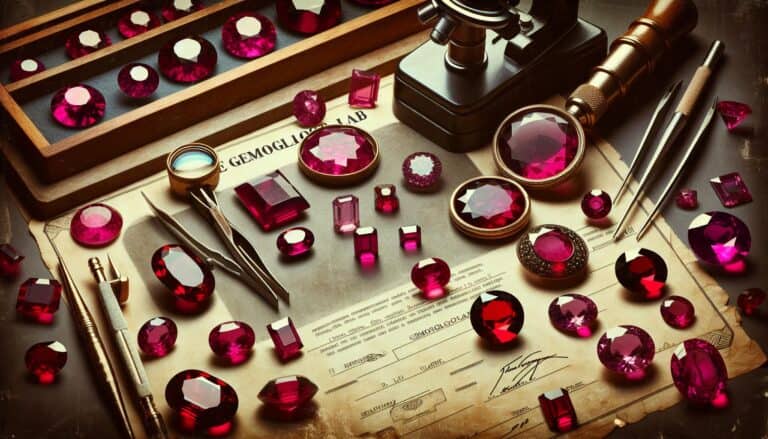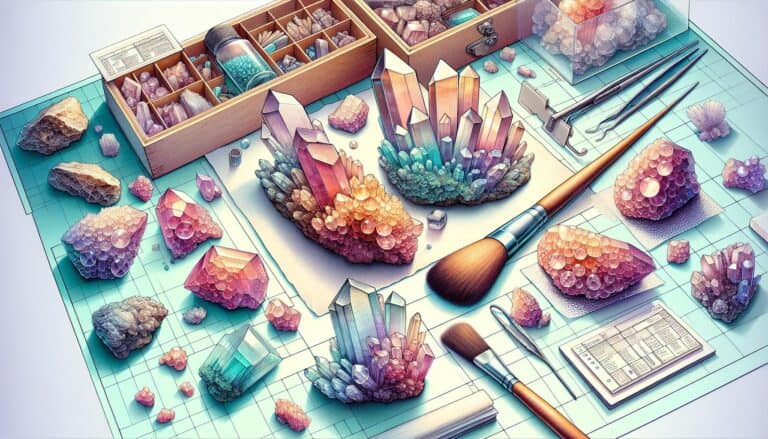Discovering the vibrant world of minerals can be as thrilling as a treasure hunt, especially when you’re on the lookout for fluorite.
Known for its dazzling array of colors and its fluorescent properties, fluorite is a favorite among collectors and enthusiasts alike. But how do you make sure you’ve truly found this gemstone?
Identifying fluorite doesn’t have to be a challenge. With its unique characteristics, such as its crystal structure, hardness, and luminosity under UV light, you’ll be spotting genuine fluorite like a pro.
Let’s dive into the key features that set this mineral apart, ensuring you can identify fluorite with confidence and ease.
To identify fluorite, look for its glassy luster, cubic crystals, and a white streak. It’s not magnetic and has a Mohs hardness of 4. Fluorite shows double refraction and has a specific gravity of 3.0-3.3. It’s found in hydrothermal veins and is fluorescent under UV light.
How to Identify Fluorite Through Testing
When you’ve got a stone that might be fluorite, you’ll want to conduct a few tests to confirm its identity. Remember, fluorite’s vibrant colors and unique properties set it apart, but the following tests will help ensure your identification is spot on. Let’s dive right into the specifics.
Visual Inspection
Start by examining the stone’s visual properties. You’re looking for a glassy luster and a well-defined crystalline shape. Fluorite often forms cubes but can also present in other less common forms like octahedrons. Colors range widely but expect to see purple, blue, green, or yellow.
The Streak Test
Take your sample and rub it against a white porcelain streak plate. Fluorite typically leaves a white streak, regardless of the color of the mineral itself. This is because the streak is the color of the mineral in powdered form and fluorite’s powder is almost always white.
Magnet Test
This test is simple: Fluorite is not magnetic. If you place a magnet near your sample and it’s attracted, you’re likely not dealing with fluorite.
Hardness Test
Fluorite falls at a 4 on the Mohs scale of hardness. You can test this by trying to scratch it with a copper penny (which ranks at about a 3). The penny should not scratch fluorite.
Birefringence Test
Birefringence refers to a material’s ability to split light into two rays. A piece of fluorite will often exhibit this phenomenon when looked at through a polarizing filter. This can create the illusion of double edges on the crystal facets.
Checking The Diaphaneity
Fluorite’s diaphaneity — its transparency to light — can be transparent, translucent, or opaque. Hold the stone up to a light source and see how much light passes through to assess its diaphaneity.
Single or Double Refraction
Another test for identification is observing if the mineral has single or double refraction. While fluorite itself is not doubly refractive, impurities within it may cause some double refraction effects.
Refractive Index Test
Professional gemologists can measure the refractive index of a gem to help identify it. Fluorite’s refractive index ranges from 1.433 to 1.454, which can separate it from other minerals when using a refractometer.
Finding The Specific Gravity
The specific gravity refers to the density of the mineral compared to water. Fluorite’s specific gravity is around 3.0 to 3.3, which can be tested using a hydrostatic balance or electronic scale designed for gemstones.
Identifying Fluorites in the Field
When you’re out in the field, look for signs of fluorite where geological conditions favor its formation. It often accompanies minerals like quartz and calcite and is commonly found in hydrothermal veins.
Recognizing Potential Fluorite Rocks
Lastly, keep an eye out for rocks with a fluorescent glow under UV light, another key indicator of fluorite. Also, lookout for the presence of associated minerals, crystal formations, and typical fluorite color zones within the rocks.
Physical Characteristics of Fluorite

Fluorite, also known as fluorspar, has physical properties that are especially useful in its identification. You’ll notice it typically crystallizes into a cubic form, which can also manifest as octahedral shapes when it’s more developed. The cubic crystals may interpenetrate, giving rise to a distinctive appearance.
Colors of fluorite range widely from purple, blue, green, yellow, to colorless, with the possibility of finding multiple colors within a single specimen. These vibrant hues aren’t just for show; they’re a key indicator when distinguishing fluorite from other minerals.
When you handle it, you’ll feel that fluorite is considerably heavier than it looks due to its relatively high specific gravity, which usually falls between 3.0 and 3.3. Here’s a breakdown of its specific gravity compared to two common minerals:
| Mineral | Specific Gravity |
|---|---|
| Quartz | 2.65 |
| Calcite | 2.71 |
| Fluorite | 3.0 – 3.3 |
Its hardness on the Mohs scale ranks at a 4, which means it’s softer than most other collectible minerals. This softness should be considered if you’re looking to polish or facet fluorite, as it can affect the long-term durability of the material. Additionally, fluorite exhibits perfect cleavage in four directions, meaning it can split with relative ease and produce smooth, flat surfaces which add to its aesthetic appeal.
Look for a glassy luster; when you turn a fluorite sample in the light, it should exhibit a bright, vitreous shine. Another feature to observe is its transparency. Fluorite can be transparent to translucent, sometimes within the same crystal which contributes to its allure amongst collectors and gem enthusiasts.
Remember, these physical characteristics are just one part of identifying fluorite. They contribute to a bigger picture when combined with geological context and various tests, ensuring you can positively identify this vibrant mineral wherever you might come across it.
How Are Fluorite Formed?
Understanding how fluorite is formed will give you more insight when identifying this mineral. Fluorite is typically a product of hydrothermal processes. These processes involve very hot fluids that flow through the fractures and cavities of the Earth’s crust.
During these hydrothermal activities, fluoride-rich solutions, mainly composed of water heated by magma or circulated deep in the Earth’s crust, cool and precipitate minerals. As the temperature and pressure change, elements like calcium and fluoride, which make up fluorite, combine to form this vibrant crystal.
Several factors contribute to the formation of fluorite:
- Temperature and Pressure: Fluorite often forms at low to medium temperatures and pressures.
- Chemical Composition: The presence of calcium and fluoride in the solution is critical.
- Geological Setting: It’s typically found in vein deposits, often associated with metallic minerals.
The color zonation in fluorite crystals, which can be remarkably intricate, reflects the changes in the chemical environment as the crystal grows. Each band represents a shift in the conditions during the crystallization process, allowing you to read a geological history through the stone. In essence, the formation of fluorite is a testament to the dynamic processes that occur beneath our feet.
Preparation for Fluorite Hunting
Gathering the Right Tools
Before you embark on your adventure to unearth the vibrant beauty of fluorite, you’ll want to ensure you’ve got the right tools packed. Rock hammers, chisels, and safety goggles are essential to safely extract samples. Don’t forget a sturdy backpack or pail to transport your finds. For close examination of potential fluorite samples, a hand lens or jeweler’s loupe is indispensable.
You’ll also benefit from bringing along a field guide that details the types of rocks and minerals common to the area you’re exploring. While smartphones and apps can be helpful, remember that connectivity may be unreliable in remote hunting grounds. Having a GPS device or detailed topographical maps can prevent losing your bearings.
- Rock hammer: to chisel through rock
- Chisel set: for precise breaking
- Safety goggles: to protect your eyes
- Backpack/pail: for carrying specimens
- Hand lens or loupe: for close examination
- Field guide: for rock identification
- GPS map: for navigation
These items not only facilitate successful hunting but also ensure the integrity of your specimens remains intact for further analysis.
Safety Considerations
Embarking on fluorite hunting presents its set of hazards, so prioritizing safety cannot be overstressed. Wear proper protective clothing, including gloves, long sleeves, and pants to guard against sharp rocks and potentially hazardous terrain. A hard hat should be worn in areas where falling rocks are a possibility, such as mines or cliffsides.
Always inform someone of your plans and return time when you’re heading into less traveled areas. Keep a first-aid kit accessible at all times, and pack plenty of water to stay hydrated. Be aware of local wildlife and weather conditions, as both can turn unexpectedly.
Don’t underestimate the terrain. Ensure you have the right footwear—boots with a solid grip and ankle support are best to navigate uneven ground.
In summary:
- Wear protective clothing
- Don’t forget the hard hat
- Inform someone of your plans
- Have a first-aid kit ready
- Stay hydrated
- Check the weather forecast
- Choose the right footwear
With these precautions in mind, you’re set for a safer, more rewarding fluorite hunting experience. Remember, the best treasure seeker is the one who comes home safe, ready to share their discoveries with the world.
Handling and Care of Found Fluorite

Once you’ve successfully located and collected fluorite specimens, proper handling and care become paramount to preserving their quality and luster. Your newfound treasures require attention to maintain their condition.
Cleaning Fluorites
The first step you’ll want to take is cleaning your fluorite. This process involves several key methods:
- Rinse your fluorite under lukewarm running water to remove any loose dirt or debris. Avoid hot water as it might cause fractures.
- Use a soft brush, like a toothbrush, to gently scrub the surface. Apply a mild soap if necessary, but make sure to rinse thoroughly to remove soapy residue.
- For tougher grime, you could opt for a soak in a solution of warm water and dish soap. Limit soaks to avoid potential damage.
- Air dry your stones or pat them dry with a soft towel, ensuring moisture is gone to prevent water spots.
Storing Fluorites
After your fluorites are clean and dry, you’ll need to store them properly to prevent damage. Keep the following storage tips in mind:
- Separate your fluorites from other minerals to prevent scratches. Fluorite’s hardness is lower than many other substances.
- Wrap each specimen in a soft cloth or place it in a padded container.
- Store your fluorites in a cool, dry place away from direct sunlight to avoid color fading.
- Consider using display cases with a soft lining to show off your fluorites without exposing them to dust and environmental factors.
By adhering to these cleaning and storage strategies, you’ll ensure that your fluorite specimens remain as lustrous as the day you found them. Remember, fluorites are not only stunning but also valuable for their unique properties and should be handled with care to retain their appeal.
Conclusion: Confirming Fluorite is Real
Now that you’ve got the know-how to identify and care for your fluorite finds, you’re well on your way to becoming an adept collector.
Remember, proper cleaning and storage are just as crucial as the initial identification. With these tips at your fingertips, you’ll keep your fluorite specimens in pristine condition, showcasing their unique beauty for years to come.
So go ahead, apply what you’ve learned and enjoy the colorful world of fluorite collecting with confidence.







